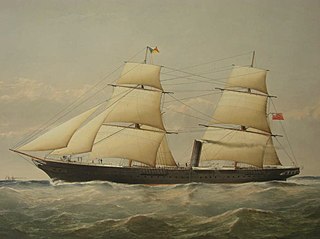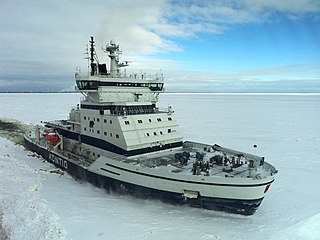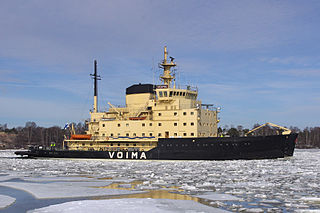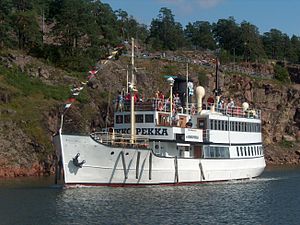History
The ship was built at Wärtsilä Hietalahti Shipyard in Helsinki, Finland in 1938 and was at the time a modern, icebreaking inspection vessel. The vessel was the first inspection vessel in independent Finland, built by the Finns for the National Board of Navigation, and her year of manufacture is the same as that of the icebreaker Sisu. She was originally known as Inspection vessel SS Turku and was built to the hull designs of SS Sisu, the only alterations being that of the scale. Thus SS Ukkopekka is probably the last sea-going passenger steamer designed for icebreaking still in active service.
The original engine of SS Ukkopekka was a triple expansion steam engine, built in Helsinki in 1937, and originally designed for warships by the Germans. This engine is probably the last one in active use in the whole world. The engine is in very good condition, as the Finnish state took very good care of it. The boiler was renewed in 1976. The hull is surveyed every two years and it is still in excellent condition—thanks to the high quality steel of 1937.
Soon after she had been built, SS Turku was transferred to military service. The ship served during the Winter War (1939–1940). Despite the extreme conditions of that very harsh winter, the ship was in active service almost without a break. During the Continuation War (1941–1944), the vessel served as a convoy ship in the Åland Sea. After the war, the vessel returned to her original task, serving the National Board of Navigation (pilotage service) as a maintenance and inspection vessel on the Archipelago Sea. Pilot training was part of the daily routine on board, and so was sea mark maintenance.
In her home port, the lower steamship port of Turku, the coal trimmer soon became the subject of many letters to the editor and received complaints from the residents of apartment houses on the banks of the Aura River, who claimed that the soot from her chimneys made their laundry dirty. As a result, the coal stores were replaced by oil containers in 1976, and the boiler hatches were replaced with oil-driven blowers. The rest of the engine has been preserved unaltered, in its original shape. There are five steam engines altogether: the main engine, winch engine, rudder engine and two water pumps. This engine is a popular attraction among steam enthusiasts who come from all over the world to admire the "museum piece”. The engine remains in excellent condition and in active use. It is expected to remain operable for decades.
The Finnish state gave up the vessel in 1979, when a new, larger and more modern inspection vessel was built. After some alteration work on deck and inside the vessel, steamship traffic was reintroduced in the Turku region in the spring of 1986. This marked the first return of traditional steaming in the area since the 1950s.
In the winter of 1987–1988, the ship saloons were enlarged and renovated. The kitchen and storage facilities were also renovated to meet modern requirements and service standards.
SS Ukkopekka.
SS Ukkopekka in drydock 2005.
SS
Ukkopekka off
Kultaranta, the residence of the Finnish president.
SS Ukkopekka. Old anchor machine.
SS Ukkopekka.
SS Ukkopekka goes under the Ukkopekka bridge.
SS Ukkopekka off the island of Loistokari

A steamship, often referred to as a steamer, is a type of steam-powered vessel, typically ocean-faring and seaworthy, that is propelled by one or more steam engines that typically move (turn) propellers or paddlewheels. The first steamships came into practical usage during the early 1800s; however, there were exceptions that came before. Steamships usually use the prefix designations of "PS" for paddle steamer or "SS" for screw steamer. As paddle steamers became less common, "SS" is assumed by many to stand for "steamship". Ships powered by internal combustion engines use a prefix such as "MV" for motor vessel, so it is not correct to use "SS" for most modern vessels.

SS Carnatic was a British steamship built in 1862-63 by Samuda Brothers at Cubitt Town on the Isle of Dogs, London, for the Peninsular and Oriental Steam Navigation Company (P&O). She operated on the Suez to Bombay run in the last years before the Suez Canal was opened. This route gave a fast, steamship-operated route from Britain to India, connecting with similar steamships running through the Mediterranean to Alexandria, with an overland crossing to Suez. The alternative was to sail round the Cape of Good Hope, a distance at which steam ships were not, in the early 1860s, sufficiently economical to be commercially competitive with sail.

A steamboat is a boat that is propelled primarily by steam power, typically driving propellers or paddlewheels. Steamboats sometimes use the prefix designation SS, S.S. or S/S or PS ; however, these designations are most often used for steamships.

An icebreaker is a special-purpose ship or boat designed to move and navigate through ice-covered waters, and provide safe waterways for other boats and ships. Although the term usually refers to ice-breaking ships, it may also refer to smaller vessels, such as the icebreaking boats that were once used on the canals of the United Kingdom.

RMS Segwun is the oldest operating steam driven vessel in North America, built in 1887 as Nipissing to cruise the Muskoka Lakes in the Muskoka, Ontario, Canada, a resort area with many lakes and rivers. Early in the 20th century, Muskoka was poorly served by roads. Vacationers were transported to lodges, or private cottages, via a fleet of steamships. Segwun is the oldest of only three ships in the world still carrying the status of Royal Mail Ship, and the only steamer.

MS Bore is a combination museum and hotel ship docked permanently in Turku, Finland. She was originally built in 1960 by Oskarshamn shipyard, Oskarshamn, Sweden as the car/passenger ferry SS Bore for Steamship Company Bore, Finland, then the last commercial steam ship built in Scandinavia and the first ferry on the route between Finland and Sweden where cars could drive aboard. She was later known as SS Borea, before being rebuilt as a cruise ship in 1988. 1988 to 2010 she was owned by the Finnish shipping company Kristina Cruises and known as MS Kristina Regina until she was retired because she did not comply with new safety regulations.

SS Sirius was a wooden-hulled sidewheel steamship built in 1837 by Robert Menzies & Sons of Leith, Scotland for the London-Cork route operated by the Saint George Steam Packet Company. The next year, she opened transatlantic steam passenger service when she was chartered for two voyages by the British and American Steam Navigation Company. By arriving in New York a day ahead of the Great Western, she is usually listed as the first holder of the Blue Riband, although the term was not used until decades later.

Tarmo is a Finnish steam-powered icebreaker preserved in the Maritime Museum of Finland in Kotka. Built in 1907 by Sir W.G. Armstrong, Whitworth & Co Ltd in Newcastle upon Tyne, United Kingdom, she was the third state-owned icebreaker of Finland and the last Finnish steam-powered icebreaker to remain in service. When Tarmo was decommissioned in 1970, a decision was made to preserve the vessel as a museum ship. After a long wait in Helsinki, Tarmo was towed to Kotka and completely restored in the early 1990s.

MS Golden Princess was a casino cruise ship owned by Eurasia International, operated on short casino cruises out of Hong Kong. She was built in 1967 by the Wärtsilä Hietalahti shipyard in Helsinki, Finland as Finlandia for the Finland Steamship Company. In 1975 she was sold to Finnlines, who converted her into the cruise ship Finnstar in 1978. In 1982 she entered service for Pearl Cruises as Pearl of Scandinavia. In 1988 she was renamed Ocean Pearl. In 1994 she entered service with Croisières Paquet as Pearl. Between 1995 and 1998 she sailed for Costa Cruises as Costa Playa. In 1998-1999 she sailed as Oriental Pearl for Mega Wave International, and in 1999-2000 as Joy Wave for Costa Cruises. In 2000 she was sold to Eurasia International and entered service under the name Golden Princess. In 2009 she was sold for scrap to China.

Kontio is a Finnish state-owned icebreaker. Built by Wärtsilä Helsinki shipyard in 1987 as a replacement for the aging Karhu-class icebreakers, she and her sister ship Otso were the first Finnish post-war icebreaker to be built without bow propellers.

Sampo was a Finnish state-owned steam-powered icebreaker. Built in 1898 by Sir W.G. Armstrong, Whitworth & Co Ltd in Newcastle upon Tyne, United Kingdom and named after a magical artifact from the Finnish mythology, she was the second state-owned icebreaker of Finland and the first European icebreaker equipped with a bow propeller. When Sampo was decommissioned and broken up in 1960, she was also the second last steam-powered icebreaker in the Finnish icebreaker fleet.

Murtaja was a Finnish state-owned steam-powered icebreaker. Built in 1890 by Bergsunds Mekaniska Verkstads AB in Stockholm, Sweden, she was the first state-owned icebreaker of Finland and one of the first purpose-built icebreakers in the world. Murtaja remained in service for 68 years until she was decommissioned and broken up in 1958 after having been replaced by the diesel-electric Karhu.

Apu was a Finnish state-owned steam-powered icebreaker built by Howaldtswerke in Kiel, Germany, in 1899. Initially owned by a private shipping company founded by shipowners from the Finnish city of Turku and known as Avance, she was later purchased by the Finnish Board of Navigation and her name was translated into Finnish. Apu remained in service until 1959, when she was replaced by the new diesel-electric Murtaja.

Voima was a Finnish and later Soviet steam-powered icebreaker. Laid down at Werft Becker & Co. in Tallinn in 1916 and fitted with engines in Danzig in 1918, the unfinished icebreaker was towed to Helsinki in 1920 and completed by Sandvikens Skeppsdocka och Mekaniska Verkstads Ab in 1923–1924. After two decades of successful service Voima was handed over to the Soviet Union as war reparation in 1945 and renamed Malygin (Малыгин). She remained in service until 1970 and was broken up in 1971.

Suur Tõll is an Estonian steam-powered icebreaker preserved in the Estonian Maritime Museum in Tallinn. She was originally built for the Russian Empire in 1914 by AG Vulcan in Stettin, Germany, as Tsar Mikhail Feodorovich. In 1917, she was taken over by the Bolsheviks and renamed Volynets. However, in 1918 she was captured by Finland and served as Wäinämöinen until 1922, when she was handed over to Estonia according to the Treaty of Tartu and renamed Suur Tõll. When Estonia was occupied by the Soviet Union in 1940, the icebreaker rejoined the Soviet fleet and was again named Volynets. She remained in service until 1985.

Jääkarhu was a Finnish and later Soviet steam-powered icebreaker. Built in 1926 by P. Smit Jr. Shipbuilding and Machine Factory in Rotterdam, Netherlands, she was the last and largest steam-powered state-owned icebreaker of Finland. After two decades of successful service, Jääkarhu was handed over to the Soviet Union as war reparation in 1945 and renamed Sibiryakov. She remained in service until the 1970s and was broken up in 1972.

Voima is a Finnish state-owned icebreaker. Built by Wärtsilä Hietalahti shipyard in Helsinki in 1954, she was the first icebreaker in the world to be equipped with two bow propellers and generated widespread publicity that helped the Finnish shipbuilding industry to become the world leader in icebreaker design.

Otso is a Finnish state-owned icebreaker. Built by Wärtsilä Helsinki shipyard in 1986 to replace the aging Karhu-class icebreakers, she was the first Finnish post-war icebreaker to be built without bow propellers. Otso has an identical sister ship, Kontio, which was delivered in 1987.

Polaris is a Finnish icebreaker. Built in 2016 by Arctech Helsinki Shipyard, she is the most powerful icebreaker ever to fly the Finnish flag and the first icebreaker in the world to feature environmentally friendly dual-fuel engines capable of using both low-sulfur marine diesel oil (LSMDO) and liquefied natural gas (LNG). Polaris was initially ordered by the Finnish Transport Agency, but the ownership was transferred to the state-owned icebreaker operator Arctia after delivery.

Sisu was a Finnish state-owned icebreaker. Built in 1939 at Wärtsilä Hietalahti Shipyard in Helsinki, she was one of the world's first diesel-electric icebreakers. In addition to icebreaking duties, she served as a submarine tender for the Finnish Navy during the summer months until the end of the Continuation War.




























